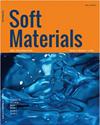第一酚酞基六烯醚的合成、液晶自组装、有机凝胶行为及DFT研究
IF 1.4
4区 材料科学
Q4 MATERIALS SCIENCE, MULTIDISCIPLINARY
引用次数: 0
摘要
摘要有机分子中不同的组成单元可以诱导复杂的分子间相互作用,从而在体态和溶液态下形成不同的超分子微纳米结构。本文采用咔嗒反应合成了第一个新的酚酞基六烯醛,该六烯醛含有一个中心酚酞荧光染料,并被两个枝状翼功能化。偏光显微镜、差示扫描量热法和小角度x射线衍射数据表明,所报道的酚酞基六正烯醛在体态下可以自组装成六方柱状中间相,并且由于分子间相互作用,在一些常见的有机溶剂中可以形成具有不同形态的有机凝胶。密度泛函理论计算结果表明,分子构象高度扭曲,电荷分布明显,电子性质不对称,这可能是柱状中间相和有机凝胶稳定的必要条件。因此,这项工作提供了一种方法来开发含有不同功能的具有复杂自组装的软材料。感谢中国北京同步辐射设施(BSRF)的李志宏教授和光束线1W2A提供的SAXS测试和数据分析。披露声明作者未报告潜在的利益冲突。补充数据本文的补充数据可通过https://doi.org/10.1080/1539445X.2023.2261430.Additional info在线获取。[412821],四川省化学合成与污染控制重点实验室重大专项基金[No. 412821];四川省科学技术厅[CSPC202101];国家自然科学基金资助项目[2022NSFSC1237];22265030)。本文章由计算机程序翻译,如有差异,请以英文原文为准。
Synthesis, liquid crystalline self-assembly, organogel behavior, and DFT investigation of first phenolphthalein-based hexacatenar
ABSTRACTDifferent building blocks in organic molecules could induce complex intermolecular interactions to lead to different supramolecular micro/nanostructures in bulk and solution states. Herein, the first new phenolphthalein-based hexacatenar containing a central phenolphthalein fluorochrome functionalized with two dendritic wings is synthesized by click reaction. The polarized optical microscopy, differential scanning calorimetry, and small-angle X-ray diffraction data demonstrated that the reported phenolphthalein-based hexacatenar could self-assemble into hexagonal columnar mesophase in the bulk state and could form organogel with distinct morphologies in some common organic solvents due to intermolecular interactions. Density functional theory calculation results showed highly twisted molecular conformation, distinct charge distribution, and asymmetrical electronic property, which might be essential for the stabilization of columnar mesophase and organogel. Therefore, this work provides a method to develop soft materials containing different functional building blocks with complex self-assemblies.KEYWORDS: Hexacatenarliquid crystalorganogelphenolphthalein AcknowledgmentsWe thank Professor Zhihong Li and beamline 1W2A at Beijing Synchrotron Radiation Facility (BSRF), China, for providing SAXS testing and data analysis.Disclosure StatementNo potential conflict of interest was reported by the author(s).Supplementary DataSupplemental data for this article can be accessed online at https://doi.org/10.1080/1539445X.2023.2261430.Additional informationFundingThis work was supported by China West Normal University Doctor Startup Fund [No. 412821], Major project funds of Chemical Synthesis and Pollution Control Key Laboratory of Sichuan Province [No. CSPC202101], The Science and Technology Department of Sichuan Province [No. 2022NSFSC1237] and Natural Science Foundation of China [No. 22265030].
求助全文
通过发布文献求助,成功后即可免费获取论文全文。
去求助
来源期刊

Soft Materials
工程技术-材料科学:综合
CiteScore
2.90
自引率
0.00%
发文量
21
审稿时长
2.2 months
期刊介绍:
Providing a common forum for all soft matter scientists, Soft Materials covers theory, simulation, and experimental research in this rapidly expanding and interdisciplinary field. As soft materials are often at the heart of modern technologies, soft matter science has implications and applications in many areas ranging from biology to engineering.
Unlike many journals which focus primarily on individual classes of materials or particular applications, Soft Materials draw on all physical, chemical, materials science, and biological aspects of soft matter. Featured topics include polymers, biomacromolecules, colloids, membranes, Langmuir-Blodgett films, liquid crystals, granular matter, soft interfaces, complex fluids, surfactants, gels, nanomaterials, self-organization, supramolecular science, molecular recognition, soft glasses, amphiphiles, foams, and active matter.
Truly international in scope, Soft Materials contains original research, invited reviews, in-depth technical tutorials, and book reviews.
 求助内容:
求助内容: 应助结果提醒方式:
应助结果提醒方式:


